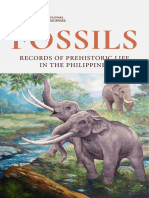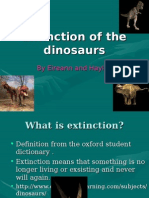Paleoher Magazine
Paleoher Magazine
Uploaded by
mellyah.setCopyright:
Available Formats
Paleoher Magazine
Paleoher Magazine
Uploaded by
mellyah.setCopyright
Available Formats
Share this document
Did you find this document useful?
Is this content inappropriate?
Copyright:
Available Formats
Paleoher Magazine
Paleoher Magazine
Uploaded by
mellyah.setCopyright:
Available Formats
PALEOHER MAGAZINE Volume-1, 2024
Fossils
In Time and Space
Prof. Vijay Sathe
Deccan College, Pune
We are told by our teachers that the age of earth runs At the outset, how do we estimate time in geological
past?
into millions of years!
What are the established time periods, era and epochs
How to count these years? that divide different stages of life in the slice of time?
What is the evidence to prove the prehistoric life on
It takes all the ten fingers of your
earth?
hands to count for about four
thousand million times to calculate How to count these years?
the time elapsed since the life
emerged for the first time on our Answers to most of these questions are coded in
planet!
one word, i.e. 'FOSSIL'.
1 Volume-1, 2024 www.paleoher.org
What is a fossil?
The term has a Latin origin, “fossilis” which defines
“any remains or imprint of a plant or animal that has been preserved in
the earth's crust since some past geologic or prehistoric time”.
Be it a fossilised bone or poop or frozen mammoths of Siberia, the foot
prints of dinosaurs or even the impressions of prehistoric plants Scientists have long observed that the coastlines of Africa and South
preserved in rocks, these diverse types of fossils are direct evidence of America are similar, and in fact, if this jigsaw puzzle if pieced together,
their existence in the past. we find the whole world looking like a mass of several amorphous pieces
of land pulled away from each other. If these pieces of land are 'pieced
together' on paper, they would resemble the ancient supercontinent
known as Pangaea. Several scientists have searched for any logical and
scientific meaning behind such fragmentation of land mass and in 1912;
it was Alfred Wegener (1912) who proposed the theory of continental
drift. Therefore don't get surprised to find taxon like a land reptile called
Lystrosaurus which lived in Africa, Antarctica and India one and the same
time! Glossopteris, fossil ferns, which were found in all the southern
continents indicate that all the continents were once joined, like
erstwhile neighbours!
What an irony that life is a subject of study but
death and burial supply all the data!
The prehistoric life was a base for the future prospects of survival, the
India offers an excellent opportunity to see the relics of prehistoric
proven fact since times immemorial. Wherever this evidence is recorded
animals buried in the ancient deposits. Dinosaurs have roamed the Indian
in the earth's surface, presents a unique opportunity to understand the
soil is evident from several localities which report their nesting
temporal and special spread of life buried in various strata across the
behaviour, clutches of eggs, a wide range of massive bones; contemporary
length and breadth of globe. No other discipline can be as much
plant life being represented by long and thick tree trunks, leaf
unraveling as palaeontology to address the origins of life with impeccable
impressions, fossil wooden logs; marine life with a variety of shells,
certainty! What has lived and perished leaves behind an array of physical
shells as large as the size of a rhinoceros, members of star fish family;
evidence which is like a trailer of past life, similar to an overnight
terrestrial animal world with early ancestors of pachyderms, equines,
experience of being in a Natural History Museum like the well-known
rhinos, hippos, camels, giraffe, tortoise, saber tooth large cats, ostriches
Hollywood movie, “A Night in the Museum” part I and II ! Interestingly
etc. that roamed the North west India (stretching from Panjab of Pakistan
we find some of them sharing their relationships with those found in
to Himachal Pradesh and beyond in the Siwalik hills) until as recent as
different continents at the same time! The separation of their 'loved
just two million years ago!
ones' and the changing shapes of the world map are two closely related
This panorama of life through ages represents India's rich natural
phenomena that hold keys to the global distribution of animals in
heritage, a priceless legacy and a great lesson in Life and Earth Sciences.
prehistoric times.
Volume-1, 2024 www.paleoher.org 2
The animal figures painted/ engraved or etched on the walls and roofs of caves and the
rock shelters are the 'bone-less' evidence of prehistoric fauna which is a continuum of
fossil record, though documented by prehistoric man and rightly called the “Painted
fossil record”. The fabled UNESCO World Heritage site of Bhimbetka in Central India is a
tall evidence of the existence of diverse prehistoric mammals whose paintings are a
testimony to the man-animal interaction in prehistory.
These are the significant signatures inscribed in the history of life, needing the world
attention for education and environmental awareness. There are several such localities
spread along the length and breadth of India that have yielded a rich fossil record ranging
in age from several hundred thousand to billion years. In recognition to this treasure
trove of fossil heritage, the Government of India has established several Fossil Parks that
have become the 'safe residences' of the buried prehistoric animals and plants which
stand as a tall testimony to the existence of prehistoric abode for animals that were
silenced by the vagaries or caprice of nature.
Fossil Parks are part of the National Geological monuments and today's the star
attraction from the geo-tourism perspective. The Fossil Parks offer detailed history of
the landscape, the evidence of life found, its significance in the context of evolution and
dispersal. One gets to know the type of fauna, its life history and position in the history
of animal kingdom. Most of these fossil sites were discovered during colonial times by
British army engineers, geologists, surgeons and natural scientists, followed by Indian
team of scientists during the past more than seven decades. The seven of the existing
Fossil Parks highlight the remains of large mammals (Saketi, District Sirmeur,
Himanchal Pradesh), Stromatalites (impression of one of the earliest forms of life on
earth, blue-green algae, Districts of Chittorgarh and Udaipur, Rajasthan),
Asias largest Marine fossil park at Mahendragarh, Districts of Sarguja, Chhattisgarh,
petrified wood (Akal, District Jaisalmer, Rajasthan), 100 million years old petrified tree
trunks (Sattanur, District Perambalur, Tamil Nadu), and fossil trees (Tiruvakkarai,
District Villupuram, Tamil Nadu). These Parks are under complete protection under the
Govt. Act of Geological Monuments. The dinosaur fossil park at Balasinor (District
Kheda, Gujarat) is a very recent addition to these existing parks highlighting the relics
of dinosaurs discovered locally. This region has emerged as the richest nesting sites and
yielded highest number of dinosaurian eggs belonging to the Late Cretaceous period. At
least thirteen species of dinosaurs lived here for more than hundred million years until
sixty-five million years of which Rajasaurus narmadaensis, and other two are the
heroes of Rayioli. It is a Fossil wood of variety of plants and trees around Jaisalmer (part
of the Great Thar desert of India) and marine fauna in Chhattisgarh would have been
unacceptable but for the prehistoric reality that we are able to understand the dynamics
and marvels of nature in the four and a half billion year's history of earth, and life that
emerged following the appearance of primordial biochemicals!
Source:Wikipedia
3 Volume-1, 2024 www.paleoher.org
You might also like
- Fossil Detectives Field GuideDocument38 pagesFossil Detectives Field Guideaoife12394% (18)
- Science You Cant See Amp-BookDocument28 pagesScience You Cant See Amp-BookMNo ratings yet
- The Beginnings of Filipino Society and Culture 1962Document5 pagesThe Beginnings of Filipino Society and Culture 1962Merra Mae S. ArmadaNo ratings yet
- PaleolibraryDocument198 pagesPaleolibraryfaure Pierrick100% (1)
- Richard Ellis Sea Dragons Predators of The PrehDocument327 pagesRichard Ellis Sea Dragons Predators of The PrehMarianoGomez67% (3)
- Prehistoric BirdsDocument31 pagesPrehistoric BirdsMarko Janković100% (5)
- Hunter-Gatherers of The Paleolithic and Mesolithic Ages: FindsDocument23 pagesHunter-Gatherers of The Paleolithic and Mesolithic Ages: FindsAnshika SinghNo ratings yet
- EarthandLifeScience Q2 Module 6 9Document38 pagesEarthandLifeScience Q2 Module 6 9benes salamancaNo ratings yet
- Earth and Life Science: Geologic Time ScaleDocument6 pagesEarth and Life Science: Geologic Time Scalebenes salamancaNo ratings yet
- WEEK-1-Evolving-Concept-of-Life-Based-on-Emerging-Pieces-of-Evidence-LECTUREDocument85 pagesWEEK-1-Evolving-Concept-of-Life-Based-on-Emerging-Pieces-of-Evidence-LECTUREglormabagasNo ratings yet
- IndexfossilsDocument27 pagesIndexfossilsかな どなりNo ratings yet
- Tortoises and Turtles KadalDocument20 pagesTortoises and Turtles Kadalvkm_ctrNo ratings yet
- Where Myth and Archaeology Meet: Discovering The Gorgon Medusa's LairDocument8 pagesWhere Myth and Archaeology Meet: Discovering The Gorgon Medusa's LairLucas LopezNo ratings yet
- PrehistoryDocument5 pagesPrehistoryapi-437973591No ratings yet
- Palaeo MesoDocument17 pagesPalaeo MesoSwarlatha PandeyNo ratings yet
- Index FossilsDocument25 pagesIndex Fossilsdiane laputNo ratings yet
- Dinosaurs BookletDocument10 pagesDinosaurs BookletNatalia ElizabethNo ratings yet
- Untitled-2Document21 pagesUntitled-2Photos preethaNo ratings yet
- Earth Science IP - History of Earth Through Geologic TimeDocument2 pagesEarth Science IP - History of Earth Through Geologic TimeStella Shane CortezNo ratings yet
- Gnostic Anthropology: One of The Skulls Found in Jebel IrhoudDocument3 pagesGnostic Anthropology: One of The Skulls Found in Jebel IrhoudNelson Daza GrisalesNo ratings yet
- science-lesson-fossils pt 123Document22 pagesscience-lesson-fossils pt 123bonillabonnie68No ratings yet
- EarlyHumanHistoryUnitFreebie-1Document10 pagesEarlyHumanHistoryUnitFreebie-1lisa.petersenNo ratings yet
- Lesson 2 - GTS and EvolutionDocument66 pagesLesson 2 - GTS and EvolutionBeng QuinnNo ratings yet
- Paleolithic Murals 2005Document2 pagesPaleolithic Murals 2005Anderson de paulaNo ratings yet
- Earth History and Geologic Time Chapter 2Document33 pagesEarth History and Geologic Time Chapter 2chescaroda2006No ratings yet
- Index Fossils (Synthesis Paper) Gwyneth Andrea T. BagaipoDocument6 pagesIndex Fossils (Synthesis Paper) Gwyneth Andrea T. BagaipobagaipogwynethNo ratings yet
- Describe How Index Fossils are Used to Define and Identify Subdivisions of the Geologic Time ScaleDocument41 pagesDescribe How Index Fossils are Used to Define and Identify Subdivisions of the Geologic Time ScaleIan DaveNo ratings yet
- Science Quarter 1 Week 7: Not For SaleDocument11 pagesScience Quarter 1 Week 7: Not For SaleWesley M. PerezNo ratings yet
- Black Green Modern Frog PosterDocument8 pagesBlack Green Modern Frog PosterNathan PeñeraNo ratings yet
- National Museum PaleoanthropologyDocument36 pagesNational Museum PaleoanthropologyHenokNo ratings yet
- JC Excellente Christian Academy Inc.: Blk. 40 Lot 73 Road 1 Minuyan II, CSJDM BulacanDocument4 pagesJC Excellente Christian Academy Inc.: Blk. 40 Lot 73 Road 1 Minuyan II, CSJDM BulacanJi PaoNo ratings yet
- EvolutionDocument40 pagesEvolutionsalvasion0329No ratings yet
- Science: Modified Strategic Intervention MaterialsDocument21 pagesScience: Modified Strategic Intervention MaterialsSanJoseHS100% (1)
- Primate Evolution: Chapter OutlineDocument22 pagesPrimate Evolution: Chapter OutlineJuan Antonio Valls FerrerNo ratings yet
- BioUnit4 25 2Document2 pagesBioUnit4 25 2emmaduman0312No ratings yet
- Chapter 29Document39 pagesChapter 29Konishko DeyNo ratings yet
- Geological Time Scale-8081695143371Document4 pagesGeological Time Scale-8081695143371Antonio RafaelNo ratings yet
- PP31. Fossils Formation and Fossil TourismDocument60 pagesPP31. Fossils Formation and Fossil TourismmtshweninhlamuloNo ratings yet
- Continental Drift Theory 1Document34 pagesContinental Drift Theory 1hygvcgygfnNo ratings yet
- Velikovsky Immanuel - Were All Dinosaurs Reptiles PDFDocument8 pagesVelikovsky Immanuel - Were All Dinosaurs Reptiles PDFmika2k01100% (1)
- 158 EarthandLifeSci12 Q1 Mod6 Geologic Time Scale and Geohazards v3Document16 pages158 EarthandLifeSci12 Q1 Mod6 Geologic Time Scale and Geohazards v3Sweet MintNo ratings yet
- Eden in The East The Drowned Continent o PDFDocument2 pagesEden in The East The Drowned Continent o PDFEka HartomyNo ratings yet
- Dino Seminar - MonographDocument11 pagesDino Seminar - MonographScribdTranslationsNo ratings yet
- EvolutionDocument88 pagesEvolutionKatelyn ValeraNo ratings yet
- BIO110 F23 Early Life Notes OrganizerDocument3 pagesBIO110 F23 Early Life Notes OrganizerbicabeezNo ratings yet
- Artifact 2 ContentDocument2 pagesArtifact 2 Contentapi-379893240No ratings yet
- Biogeography of Vertebrates: GlossaryDocument10 pagesBiogeography of Vertebrates: Glossary23371014No ratings yet
- History of Life On Earth - 210513 - 212301Document17 pagesHistory of Life On Earth - 210513 - 212301Christine FayeNo ratings yet
- ThedinosaurspackDocument16 pagesThedinosaurspackepisodebyepisodeNo ratings yet
- Chapter 1Document23 pagesChapter 1Dibyansh BhartiNo ratings yet
- Documentary NotesDocument3 pagesDocumentary NotesMy Roses Are RosèNo ratings yet
- fossilsDocument8 pagesfossilsMarko AdelNo ratings yet
- Core Science 5 - Chapter 12 (Life Goes On)Document38 pagesCore Science 5 - Chapter 12 (Life Goes On)CrazyCat DancerNo ratings yet
- Evolution PPTDocument88 pagesEvolution PPTShallaine VernNo ratings yet
- American Association For The Advancement of Science ScienceDocument11 pagesAmerican Association For The Advancement of Science ScienceHernan Gerley Alvarado RodriguezNo ratings yet
- Evolution of The Sirenia: An OutlineDocument10 pagesEvolution of The Sirenia: An Outlinelahsivlahsiv684No ratings yet
- Geologic Time ScaleDocument3 pagesGeologic Time ScaleJohn Andrae MangloNo ratings yet
- Fossils: Records of Prehistoric Life in The PhilippinesDocument86 pagesFossils: Records of Prehistoric Life in The Philippinesvinb100% (1)
- Unit 6 Lesson 1 Ali Final 2023Document38 pagesUnit 6 Lesson 1 Ali Final 2023Mona MohammedNo ratings yet
- PaleontologyDocument2 pagesPaleontologyapi-254428474No ratings yet
- NN2-ĐỀ THI THỬDocument6 pagesNN2-ĐỀ THI THỬNga BùiNo ratings yet
- Dixon, Dougal - Enciclopedia de Dinosaurios Y Animales Prehistoricos PDFDocument3 pagesDixon, Dougal - Enciclopedia de Dinosaurios Y Animales Prehistoricos PDFJose GonzalezNo ratings yet
- AnkylosaurusDocument4 pagesAnkylosaurus190030049cseNo ratings yet
- Qdoc - Tips - Cambridge-English-Advanced-2 (1) - 63-64Document2 pagesQdoc - Tips - Cambridge-English-Advanced-2 (1) - 63-64Giuliana BarboniNo ratings yet
- Extinction of DinosaursDocument16 pagesExtinction of Dinosaurswarezisgr8No ratings yet
- The History of Animal EvolutionDocument11 pagesThe History of Animal EvolutionMong GulongNo ratings yet
- Owi l04 U06 Ak Workbook PDFDocument6 pagesOwi l04 U06 Ak Workbook PDFIrindany Belen Mendoza ReyesNo ratings yet
- Unit 6: Dinosaurs - 2 Score: /15: WorksheetDocument2 pagesUnit 6: Dinosaurs - 2 Score: /15: WorksheetThieu LeNo ratings yet
- D Reading 1711Document4 pagesD Reading 1711muhammad dalfaNo ratings yet
- Assignment 3 - Edu 214Document10 pagesAssignment 3 - Edu 214api-527334258No ratings yet
- Prova 9 Ano InglesDocument6 pagesProva 9 Ano InglesLeonardo Martins de SousaNo ratings yet
- NT20200830Document13 pagesNT20200830huhumaggieNo ratings yet
- Fossils The Restless EarthDocument112 pagesFossils The Restless EarthPaleoantropologie DinamicaNo ratings yet
- Younglearners Teens Catalog ExplorationsDocument3 pagesYounglearners Teens Catalog ExplorationsMáté BulathNo ratings yet
- PURSUIT Newsletter No. 71, Third Quarter 1985 - Ivan T. SandersonDocument52 pagesPURSUIT Newsletter No. 71, Third Quarter 1985 - Ivan T. Sandersonufortean100% (1)
- Dinosaures Monster ManualDocument2 pagesDinosaures Monster ManualMaxime Carron100% (1)
- Thematic UnitDocument3 pagesThematic Unitapi-707478422No ratings yet
- 2 de Thi Thu DH Co KeysDocument15 pages2 de Thi Thu DH Co KeysPham Ba DatNo ratings yet
- Ielts Academic Reading Practice Test 28 06fc4bdb2dDocument4 pagesIelts Academic Reading Practice Test 28 06fc4bdb2dHenryNo ratings yet
- Project 2Document5 pagesProject 2baonguyet22.6No ratings yet
- The Cosmogony of The Three WorldsDocument7 pagesThe Cosmogony of The Three WorldsJan Peter de JongNo ratings yet
- Non FictionDocument60 pagesNon FictionHarvest ChristianNo ratings yet
- Integrated UasDocument8 pagesIntegrated Uasrizki eka savitriNo ratings yet
- IELTS READING FORMATDocument31 pagesIELTS READING FORMATlouis.nguyenhatanNo ratings yet
- Dangerous Dinosaurs Q & ADocument66 pagesDangerous Dinosaurs Q & AVanya RusanovaNo ratings yet

























































































